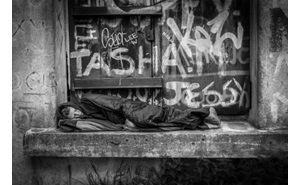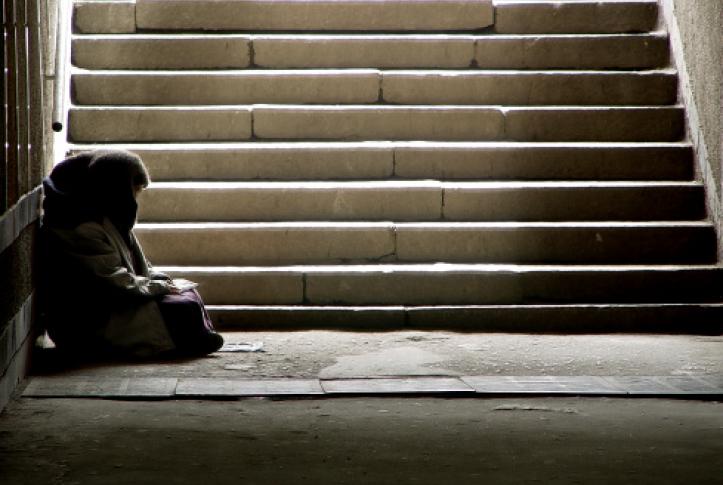Summary: Supportive housing programs that offer shelter to the homeless and a variety of medical and social services have had a dramatic impact on health outcomes and costs in communities that have implemented them. One—a pilot program in Los Angeles that focused on homeless patients who fell into the highest decile of costs—provided housing and improved access to care for patients, leading to an average cost-reduction per participant of $59,415. The spread of such programs has been hampered by lack of funding, but that may change in states that have expanded their Medicaid programs and must now find a way to control health care spending for this vulnerable population.
By Martha Hostetter and Sarah Klein
Medicaid expansion programs in 27 states and the District of Columbia will extend insurance coverage to roughly 10.5 million Americans, many with pent-up needs for primary and specialty care.1 Among the neediest will be chronically homeless individuals who as a group suffer high rates of mental illness, substance abuse disorders, and chronic conditions that are exacerbated and in some cases caused by living on the streets.2
This population is expected to be one of the costliest for newly expanded Medicaid programs and finding providers who understand the distinct physical, psychological, and social needs of the homeless will be a challenge for many states as they seek to improve the health of this population and thereby control spending.
"Providing health care for homeless individuals requires a special skill set not routinely taught in medical schools,” says Bette Iacino, vice president of public policy and communications for the Colorado Coalition for the Homeless. It's one that involves comprehensive housing strategies and numerous practice adaptations for addressing high levels of trauma and the lack of regular access to nutritious food, potable water, and safe places to rest, all of which can lead to poor health.
Among the homeless:
|
One solution that has proven effective in some parts of the country is to first provide housing and then offer a range of supports, including mental health treatment and addiction therapy, medical care, coaching, education, and employment assistance, to help the chronically homeless stabilize their lives. In some "supportive housing" programs, the homeless are housed in apartments scattered throughout a city; in others, housing units are combined with integrated behavioral and medical health clinics so that all services are provided in one place. (See case study on the Colorado Coalition for the Homeless.)
In the most well known of these models—Housing First—the newly housed don’t "earn their way" into their own apartments by first going to a shelter or halfway house, says Sam Tsemberis, CEO and Founder of Pathways to Housing, a housing services provider and advocacy group in New York. "People we house may still be struggling with addiction or mental illness. We work with them to minimize the risks these conditions bring," he says. Such programs are geared to a subset of the homeless with serious mental and/or physical disabilities who have been living on the street for extended periods—those who tend to have high health care, corrections, and other public costs.
According to Tsemberis, many people, once they are housed, voluntarily seek treatment. Giving people their own place and letting them choose which services they need—rather than making housing dependent on participation in treatment—is a key part of the model's effectiveness. "Autonomy is a huge dimension. The experience of having that is one of the healing ingredients," he says.
"Providing health care for homeless individuals requires a special skill set not routinely taught in medical schools."
—Bette Iacino, vice president of public policy and communications for the Colorado Coalition for the Homeless
The Business Case
Altogether, there were more than 284,000 supportive housing beds across the country as of January 2013.3 Communities that have such programs generally pay for them through funds from the Department of Housing and Urban Development, the Substance Abuse and Mental Health Services Administration, low-income housing tax credits, and grants. And there's substantial evidence that it's a smart investment. In one of the first studies to make the business case for supportive housing, researchers quantified the costs of both homelessness and supportive housing for 4,679 homeless, mentally ill residents of New York City from 1989 to 1997. They found that such individuals cost taxpayers $40,451 a year but that supportive housing brings these costs down by $16,282 due to reduced use of shelters, hospitals, and prisons.
A 2009 study published in the Journal of the American Medical Association found that median public costs for services—including prison, shelter and sobering centers, hospitals, alcohol and drug detoxification and treatment, emergency medical services, and Medicaid—for chronically homeless people with severe alcohol dependency in Seattle were $4,066 a month. After receiving supportive housing for six months, monthly spending on these individuals dropped by an average of $2,449, after accounting for the costs of housing. Participants also drank less, though they were not required to do so to stay in their homes.
In addition to reducing costs, there's a growing body of evidence that supportive housing leads to better health outcomes. For example, a 2009 randomized controlled trial of a Chicago supportive housing program for HIV-positive homeless patients found that housing saved lives: after one year, 55 percent of those receiving housing were alive, compared with 34 percent of those receiving "usual care." And a recent study of 99 chronically homeless people in Portland, Ore., found that in addition to significant cost reductions after two years, supportive housing residents reported greatly improved physical and mental health and—notably—a much better outlook on life.
A Range of Approaches

There are now several initiatives across the country that use supportive housing to reduce health care costs and improve care, including four programs led by the Corporation for Supportive Housing (CSH), a technical assistance, policy research, and lending group based in Washington, D.C. The initiatives (in Los Angeles; Washtenaw County, Michigan; Connecticut; and San Francisco) target the highest-cost homeless patients—the super-utilizers among an already expensive group.
In Los Angeles—where there is not nearly enough affordable housing to meet demand—the work focuses on homeless people in the highest tenth decile of spending.4 Monthly public costs for these individuals averaged $5,500 in 2009, with some 55 percent to 60 percent going toward hospital services. (By comparison, services for homeless people in the next-highest decile of spending were less than $2,000 a month.) To identify these patients, hospital staff—usually social workers—at one of the 15 participating hospitals use a triage tool that takes into account patients' housing status, number of medical and behavioral health conditions, and number of hospital and emergency department visits. Those found to be in the costliest decile of spending are then assigned a case manager from one of seven participating housing services providers, who helps them find housing, medical homes, and other services. Preliminary results of a pilot test of this approach between 2011 and 2013 found dramatically reduced service use including a 71 percent reduction in emergency department utilization, an 85 percent reduction in hospital readmissions, and an 81 percent reduction in inpatient days. The average cost-reduction per participant was $59,415, with a quarter of participants avoiding costs over $100,000.
In Washtenaw County, Michigan, which includes Ann Arbor and Ypsilanti, Avalon Housing, a housing services provider, and Catholic Social Services of Washtenaw, are working with CSH and local hospitals, mental health providers, and health clinics to identify and house the highest-cost homeless population. For example, one person served by the program is an undocumented immigrant from Japan who had been a longtime resident of city shelters, and a frequent hospital patient because of his mental illness and medically fragile condition. Supportive housing case managers were able to get him into housing within two months; they also brought in the Japanese consulate to help determine which benefits he's entitled to and worked with a local hospital to provide home health care.
"We're the helpful third party that can resolve tensions between systems, and assert our role as care coordinator and champion for clients experiencing homelessness," says Aubrey Patino Avalon Housing's director of tenant programs.
The housing programs in Los Angeles and Michigan are supported by the Social Innovation Fund, a White House initiative that seeks to promote community-based programs that have a track record of success in improving the lives of the poor.
Now Medicaid managed care organizations—which take on risk for the total health costs of beneficiaries—are also beginning to support this work. For example in Chicago, Thresholds, a mental health and housing services provider, is partnering with the IlliniCare/Cenpatico, a Medicaid managed care organization, to reduce costs for the highest-cost homeless patients with behavioral health conditions. Based on the success of a 12-month pilot, which reduced hospital costs by 60 percent and led to more appropriate use of outpatient care, IlliniCare/Cenpatico has expanded the program and agreed to pay Thresholds a per-member per-month fee for their work in engaging patients and providing therapy and other services.
"We built into that rate flexible dollars for housing," says Mark Furlong, Thresholds' vice president of clinical operations. "It's not enough support for long-term housing, but it's a baby step by a managed care company acknowledging that you need more than health care to achieve good health outcomes."
This baby step may gain traction if Illinois' plan to reform Medicaid—now under review by CMS—goes forward. As part a package of payment and delivery system

reforms and other changes to address the social determinants of health, the state would provide incentives to Medicaid health plans that invest in housing and housing support for their members with serious mental illness or substance abuse disorders.5 However, CMS has denied other states' requests (including New York's) to include supportive housing under Medicaid. In addition, the expanding use of payment models that hold providers accountable for the total costs of care may lead health care organizations to pay more attention to "upstream" factors like housing, education, and income that affect health.6 Indeed, Montefiore Medical Center, in the Bronx, has begun supporting housing for homeless patients as part of its efforts to control costs and improve health outcomes as a Pioneer accountable care organization.
Reaching out to the chronically homeless is essential. They are not "knocking down doors to ask for treatment," says Carol Wilkins, a consultant on homelessness solutions and co-author of two reports (here and here) recently released by the U.S. Department of Health and Human Services on using Medicaid funding for supportive housing services. "Part of the work involves gaining insights into what's causing their problems, establishing trust, and helping them to take small steps if they're not ready to accept a psychological diagnosis, or stop drinking," she says. In some communities, mobile units walk the streets to deliver basic care to the homeless, connect them to housing assistance, and encourage them to visit clinics.
Policy Solutions
Experts say several policy changes would give health care providers greater leverage to offer support services to the homeless as a way to improve care and control costs. First, Medicaid benefits should be flexible enough to enable managed care organizations (MCOs) and others to provide intensive case management and other services needed by beneficiaries who have been or are currently homeless.
"The federal government should make it easier for states to allow managed care plans to pay for flexible services—allow them to invest in innovation, without having to clear the big hurdle of applying for a waiver," Wilkins says.
Medicaid does pay for some community-based treatment and rehabilitation services for those with serious mental illnesses, but the benefit does not cover primary care delivered in the community. And telephone-based care management—the typical approach for MCOs—is not likely to work for the homeless. Some MCOs are investing in supportive housing services because they're convinced it will help them reduce the total costs of care. But others are dissuaded from doing so because many types of supporting housing services are not part of states' Medicaid benefit plans.
Medicaid health homes, a new type of provider created under the Affordable Care Act, may give states more options to deploy resources to care for homeless patients. Designated health homes will care for those with serious mental illnesses, substance abuse disorders, or multiple chronic conditions, supported by a 90 percent federal match for two years.
But these changes will not be sufficient unless policymakers also increase the pool of money available to support affordable housing units through rental assistance programs. "We have to figure out how to use some of the savings generated by keeping people out of emergency departments and hospitals for housing or at least housing services," says Mark Ishaug, CEO of Thresholds. "It truly all starts with affordable housing . . . and there’s simply not enough of it."
Fred Karnas, senior fellow at the Kresge Foundation, which invests in creating healthy home environments, notes CMS is already paying for housing through very expensive institutional care, but is concerned about the "slippery slope" effect of opening the door to paying for housing in the community. "That is why they should be testing the idea with pilots that could help them structure support for housing in the community in a thoughtful way that does not break the bank," Karnas says. "It is hoped that those whose health and situation improves to the point where they do not need the intensive and costly services often provided in permanent supportive housing will ultimately move to other housing, so that the more expensive supportive housing can meet the needs of those who most need it."
1. The Affordable Care Act calls for Medicaid to be expanded to cover residents with annual incomes up to 138 percent of the federal poverty level and eliminates categorical eligibility (e.g., allowing eligibility only for pregnant women). A 2012 Supreme Court decision made Medicaid expansion optional for states.
2. The 2010 Annual Homeless Assessment Report (AHAR) to Congress, U.S. Department of Housing and Urban Development, Office of Community Planning and Development. Available at https://www.hudexchange.info/resources/documents/2010HomelessAssessmentReport.pdf; M. E. Larimer, D. K. Malone, M. D. Garner et al., “Health Care and Public Service Use and Costs Before and After Provision of Housing for Chronically Homeless Persons with Severe Alcohol Problems,” Journal of the American Medical Association, April 1, 2009 301(13):1349–57. From 264,000 to 316,000 patients of federally qualified health centers (FQHCs) with Health Care for the Homeless designation are likely to gain coverage through Medicaid. From 151,000 to 172,000 patients of such FQHCs are likely to remain uninsured because they live in states that are not expanding their Medicaid programs. See National Health Care for the Homeless Council, Policy Brief: Medicaid Expansion & HCH Programs: New Possibilities, Outstanding Opportunities. Available at http://www.nhchc.org/policy-advocacy/reform/nhchc-health-reform-materials/.
3. U.S. Department of Health and Human Services, Assistant Secretary for Planning and Evaluation, Medicaid and Permanent Supportive Housing for Chronically Homeless Individuals: Emerging Best Practices from the Field, Aug. 2014, available at http://aspe.hhs.gov/daltcp/reports/2014/EmergPrac.pdf?utm_source=Homelessness+in+the+News+10.7-10.13.14&utm_campaign=Homelessness+in+the+News+9.30-10.6.14&utm_medium=email.
4. Los Angeles County's Department of Health Services has set aside $13 million to expand the pool of available units available for supportive housing.
5. Illinois' Section 1115 Medicaid waiver application was submitted in June 2014 and is under review. For details, see http://www.medicaid.gov/Medicaid-CHIP-Program-Information/By-Topics/Waivers/1115/downloads/il/il-path-transformation-pa.pdf.
6. S. Magnan, E. Fisher, D. Kindig et al., "Achieving Accountability for Health and Health Care," Minnesota Medicine, Nov. 2012 95(11):37–39. Available at https://www.mnmed.org/MMA/media/Minnesota-Medicine-Magazine/November-2012-web.pdf.
Sources for Box: Urban Institute, http://www.urban.org/publications/310291.html#table3.5; National Alliance on Mental Illness; Substance Abuse and Mental Health Services Administration, https://www.samhsa.gov/data/nsduh/state-reports-NSDUH-2014; J. Highley, Traumatic Brain Injury Among Homeless Persons: Etiology, Prevalence and Severity (National Health Care for the Homeless Council Inc., June 2008); and http://www.thelancet.com/journals/laninf/article/PIIS1473-3099%2812%2970177-9/abstract.



